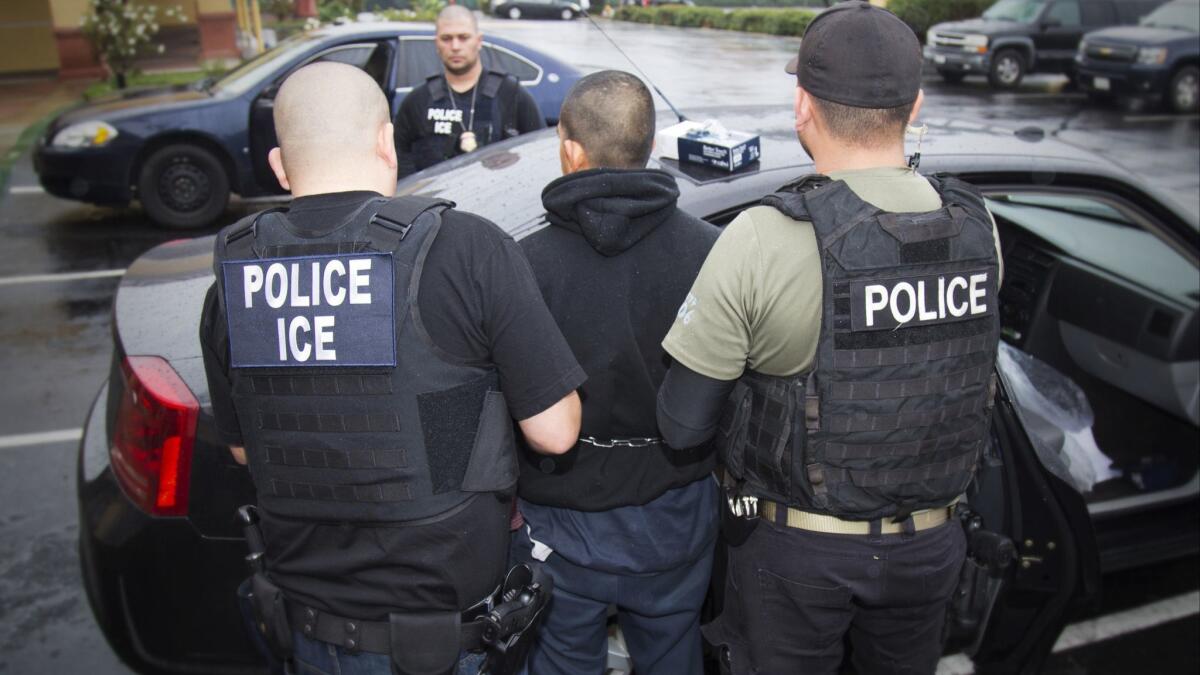ICE arrests 115 in large San Diego immigration sweep

Immigration and Customs Enforcement officers working out of the San Diego field office arrested 115 people over a large, three-day operation that ended Thursday, officials said.
Though the field office covers both San Diego and Imperial counties, all but seven of the arrests were in San Diego County. Many of the arrests were concentrated in North County, according to Greg Archambeault, field officer director for ICE Enforcement and Removal Operations in San Diego.
Officers from other parts of the country came to San Diego to help find a targeted list of immigrants who were in the country illegally who had criminal convictions or had been arrested on criminal charges, had been ordered deported by an immigration judge or had returned to the U.S. after being deported, Archambeault said.
“Operations like this reflect the vital work ERO officers do every day to protect the nation, uphold public safety and protect the integrity of our immigration laws and border controls,” Archambeault said. “We will continue to conduct similar operations, while seeking to ultimately deport at-large criminal targets and other immigration fugitives who pose a threat to public safety.”
Though reports of large-scale arrests have surfaced to much political controversy since President Trump took office, this is the first operation the San Diego field office has publicized during his administration.
“We’ve done it under different administrations,” Archambeault explained. “It’s nothing new doing a large-scale operation, but we haven’t had one here for some time.”
It was coincidental that the operation started on the day of the president’s visit to San Diego, he said.
The majority of those arrested were from Mexico. Other arrests included citizens of Honduras, Guatemala, the Czech Republic, Kazakhstan and Peru.
Forty-three percent of those arrested had criminal convictions.
The agency highlighted several arrests, including a 43-year-old man from Mexico who lived in Oceanside and was a member of the Center Street Locos gang. He had four prior deportations and multiple criminal convictions, including grand theft, controlled substance for sale and a DUI, officials said.
Officers also arrested a 55-year-old man from Kazakhstan who was wanted in his home country on charges of tax evasion and embezzlement. Interpol issued a “Red Notice” for the man in September.
People from Mexico who already have been ordered deported generally are taken quickly to the border after they’re arrested by immigration officials. Officers have to get travel documents for citizens of other countries before they can be removed.
Archambeault said officers try to start that process before making a targeted arrest.
People who have not yet been ordered deported will see an immigration judge to determine what happens to them.
Four of those arrested will be prosecuted in federal court on illegal reentry charges.
“A lot of these folks, we’ve been looking for them for a long time,” Archambeault said.
Though ICE officers can arrest green card holders who have been convicted of crimes or otherwise violated their visas, Archambeault said that all of the most recent arrests were of immigrants who were in the country illegally.
When officers planned the operation, they made a list of more than 400 targets, Archambeault said. He said finding 115 people over a period of three days is a success.
He emphasized that the operation was routine.
“It’s just another day in the life of an ICE officer,” Archambeault said. “It’s the job. It’s what we do. It’s what the mission is.
“We don’t conduct raids and sweeps,” he added.
Through daily enforcement work, local ICE officers will continue to look for those who were not found this week, Archambeault said.
Not everyone arrested was on the target list. Some were “collateral arrests,” meaning they happened to be at one of the places where officers went looking for a target, he said. The agency did not have information on the number of collateral arrests.
“While the vast majorities of cities in America do cooperate with ICE, state laws in California force ICE to focus additional resources to conduct at-large arrests in the community, putting officers, the general public and aliens at greater risk and increase the incidents of collateral arrests,” ICE said in a statement announcing the arrests.
The Trump administration recently sued the state of California over Senate Bill 54, which took effect in January and limits what local law enforcement can communicate to federal immigration officers.
Archambeault said his field office has a good relationship with local law enforcement in San Diego, but he said the new law has created a challenge. His officers no longer know when people they want to arrest are being released from the county jail because the sheriff’s office is not allowed to tell them.
“It’s going to take more time and ultimately more money to pick someone up,” he said.
Archambeault anticipated that the agency would continue to use large-scale operations but did not know how far into the future that might be.
Morrissey writes for the San Diego Union-Tribune.
More to Read
Start your day right
Sign up for Essential California for news, features and recommendations from the L.A. Times and beyond in your inbox six days a week.
You may occasionally receive promotional content from the Los Angeles Times.





